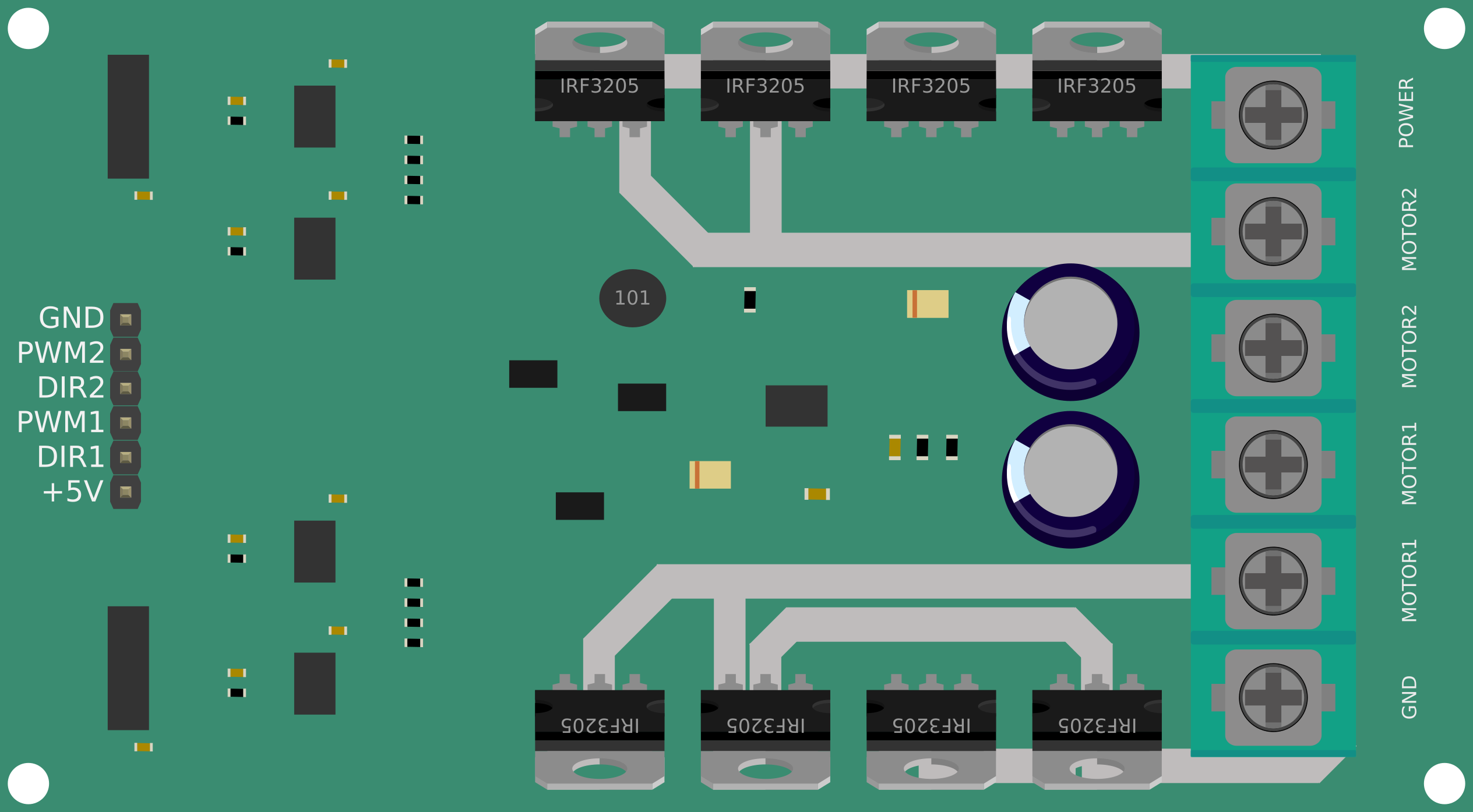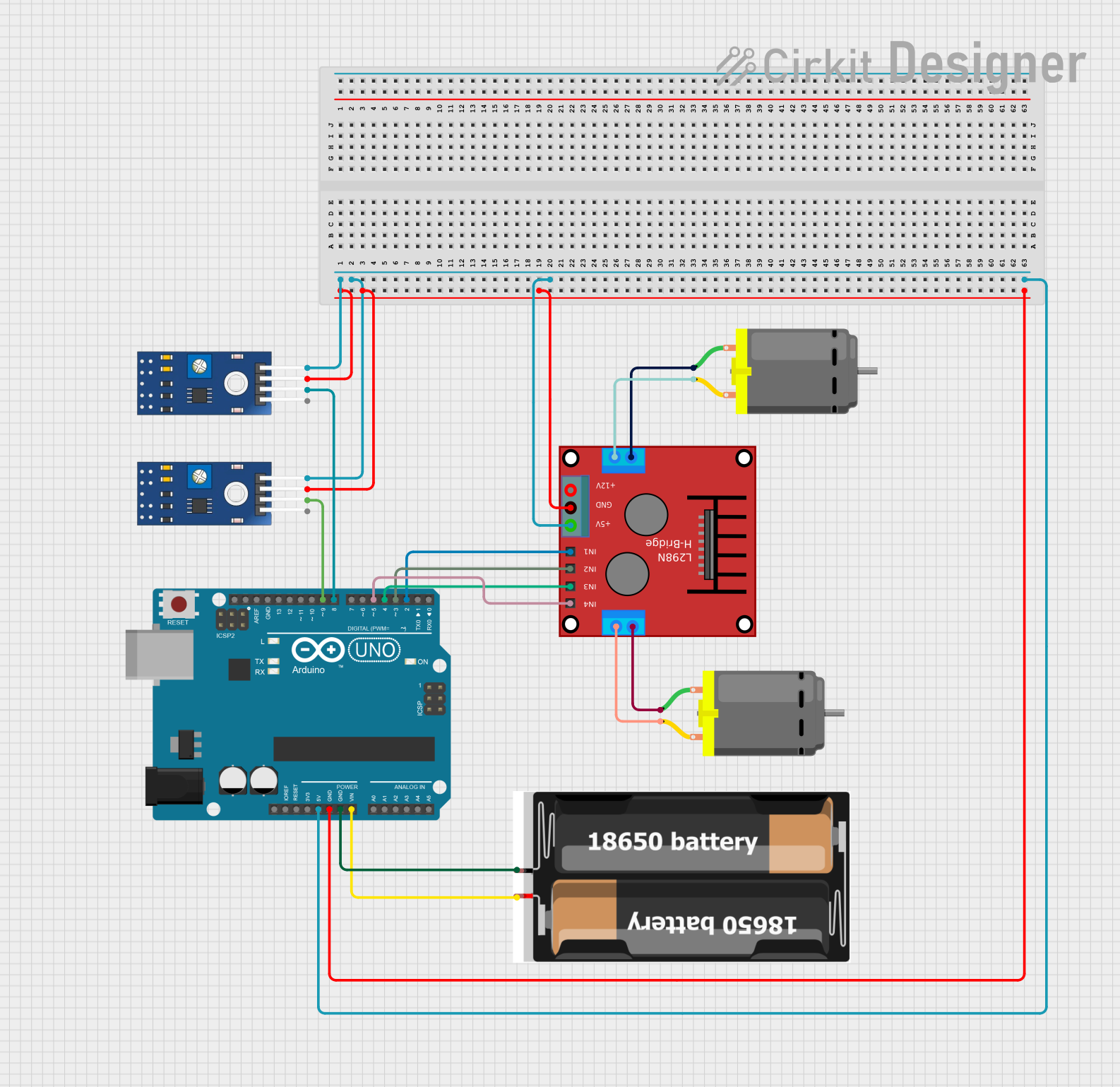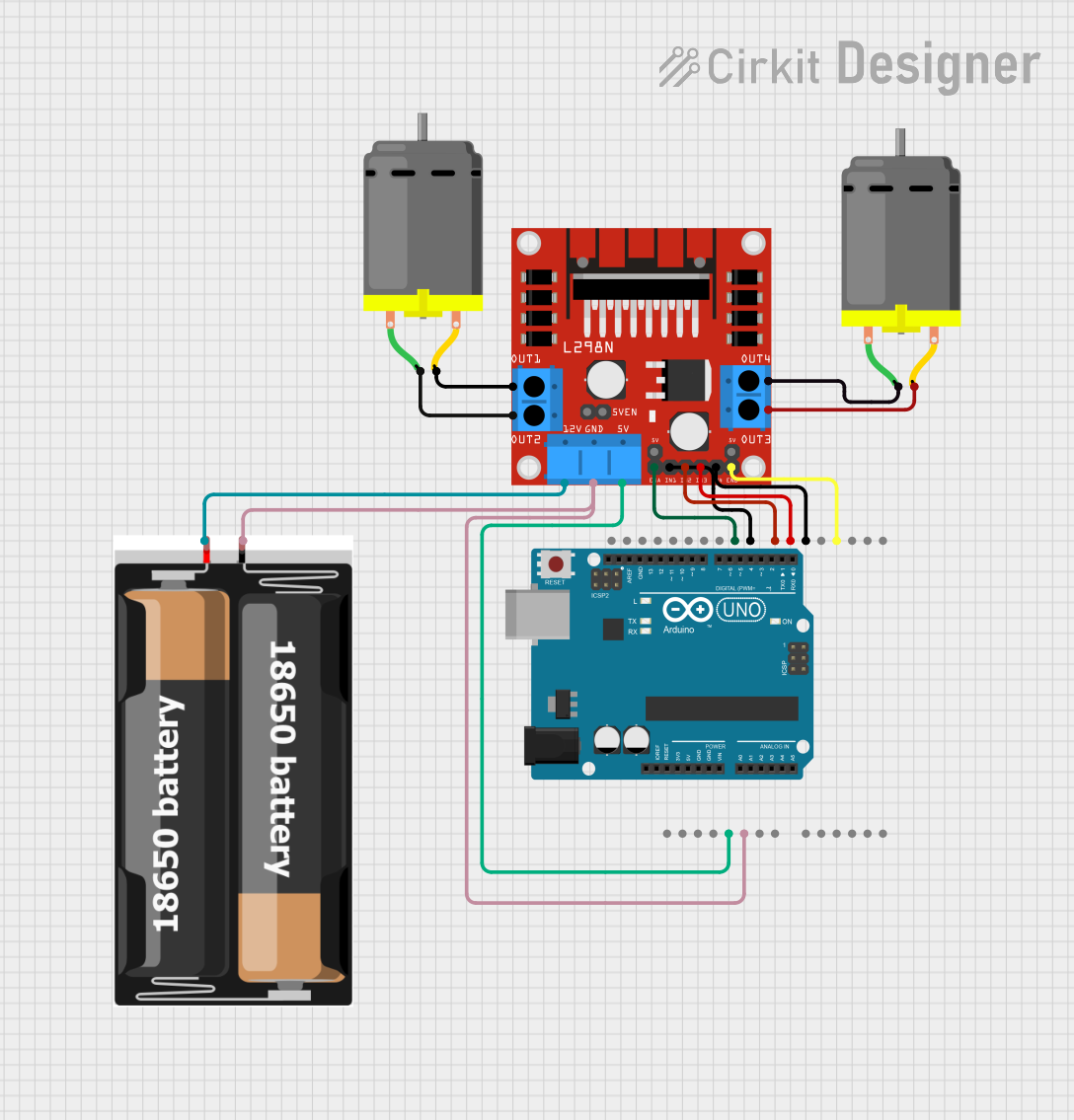
How to Use IRF3205 H-Bridge: Examples, Pinouts, and Specs

 Design with IRF3205 H-Bridge in Cirkit Designer
Design with IRF3205 H-Bridge in Cirkit DesignerIntroduction
The IRF3205 is a high-speed N-channel MOSFET commonly used in H-bridge configurations for driving motors and other inductive loads. Its low on-resistance and high current handling capabilities make it ideal for efficient power conversion and control applications. The H-bridge configuration allows for bidirectional control of DC motors, making it a popular choice in robotics, motor drivers, and power management systems.
Explore Projects Built with IRF3205 H-Bridge

 Open Project in Cirkit Designer
Open Project in Cirkit Designer
 Open Project in Cirkit Designer
Open Project in Cirkit Designer
 Open Project in Cirkit Designer
Open Project in Cirkit Designer
 Open Project in Cirkit Designer
Open Project in Cirkit DesignerExplore Projects Built with IRF3205 H-Bridge

 Open Project in Cirkit Designer
Open Project in Cirkit Designer
 Open Project in Cirkit Designer
Open Project in Cirkit Designer
 Open Project in Cirkit Designer
Open Project in Cirkit Designer
 Open Project in Cirkit Designer
Open Project in Cirkit DesignerCommon Applications and Use Cases
- DC motor control in robotics and automation
- Power inverters and converters
- High-current switching applications
- Battery-powered systems
- Stepper motor drivers
Technical Specifications
Key Technical Details
| Parameter | Value |
|---|---|
| MOSFET Type | N-Channel |
| Maximum Drain-Source Voltage (VDS) | 55V |
| Maximum Continuous Drain Current (ID) | 110A |
| Gate Threshold Voltage (VGS(th)) | 2.0V - 4.0V |
| Maximum Gate-Source Voltage (VGS) | ±20V |
| RDS(on) (On-Resistance) | 8 mΩ (at VGS = 10V) |
| Power Dissipation (PD) | 200W |
| Operating Temperature Range | -55°C to +175°C |
| Package Type | TO-220 |
Pin Configuration and Descriptions
| Pin Number | Pin Name | Description |
|---|---|---|
| 1 | Gate (G) | Controls the MOSFET switching (connected to PWM) |
| 2 | Drain (D) | Connected to the load (e.g., motor or resistor) |
| 3 | Source (S) | Connected to ground or the negative terminal |
Usage Instructions
How to Use the IRF3205 in an H-Bridge Circuit
H-Bridge Configuration:
An H-bridge consists of four MOSFETs (two IRF3205s for the low side and two P-channel or N-channel MOSFETs for the high side). This configuration allows for bidirectional control of a DC motor by alternating the current flow through the motor.Gate Drive Requirements:
- The IRF3205 requires a gate voltage (VGS) of at least 10V for optimal performance. Use a gate driver circuit or a microcontroller with a logic-level MOSFET driver to ensure proper switching.
- Avoid leaving the gate floating; use a pull-down resistor (e.g., 10kΩ) to prevent accidental switching.
Power Supply Considerations:
- Ensure the power supply voltage does not exceed the maximum VDS rating of 55V.
- Use decoupling capacitors (e.g., 100µF electrolytic and 0.1µF ceramic) near the power supply to reduce noise and voltage spikes.
Heat Dissipation:
- The IRF3205 can handle high currents, but it generates heat during operation. Use a heatsink or active cooling to maintain safe operating temperatures.
Sample Circuit Diagram:
Below is a simplified H-bridge circuit using IRF3205 MOSFETs for motor control:+V (Power Supply) | |----+----+----+ | | | D1 D2 Motor | | | GND GND GND
Arduino UNO Example Code
The following code demonstrates how to control a DC motor using an H-bridge with IRF3205 MOSFETs and an Arduino UNO.
// Define motor control pins
const int motorPin1 = 9; // PWM pin for one side of the H-bridge
const int motorPin2 = 10; // PWM pin for the other side of the H-bridge
void setup() {
// Set motor pins as outputs
pinMode(motorPin1, OUTPUT);
pinMode(motorPin2, OUTPUT);
}
void loop() {
// Rotate motor in one direction
analogWrite(motorPin1, 255); // Full speed forward
analogWrite(motorPin2, 0); // Stop the other side
delay(2000); // Run for 2 seconds
// Rotate motor in the opposite direction
analogWrite(motorPin1, 0); // Stop one side
analogWrite(motorPin2, 255); // Full speed reverse
delay(2000); // Run for 2 seconds
// Stop the motor
analogWrite(motorPin1, 0);
analogWrite(motorPin2, 0);
delay(1000); // Pause for 1 second
}
Important Considerations and Best Practices
- Gate Drive Voltage: Ensure the gate voltage is sufficient to fully turn on the MOSFET (10V recommended).
- Flyback Diodes: Use flyback diodes across the motor terminals to protect the MOSFETs from voltage spikes caused by inductive loads.
- Current Limiting: Add a current-limiting resistor or fuse to prevent damage to the MOSFETs in case of a short circuit.
- PCB Layout: Use wide traces for high-current paths and minimize the distance between the MOSFETs and the load.
Troubleshooting and FAQs
Common Issues and Solutions
MOSFET Overheating:
- Cause: Insufficient cooling or high RDS(on).
- Solution: Attach a heatsink or use active cooling. Ensure the gate voltage is at least 10V to minimize on-resistance.
Motor Not Rotating:
- Cause: Incorrect wiring or insufficient gate drive voltage.
- Solution: Double-check the circuit connections and ensure the gate voltage is within the recommended range.
MOSFET Not Switching:
- Cause: Floating gate or damaged MOSFET.
- Solution: Add a pull-down resistor to the gate and test the MOSFET with a multimeter.
Voltage Spikes Damaging the MOSFET:
- Cause: Inductive load without flyback diodes.
- Solution: Add flyback diodes across the motor terminals to suppress voltage spikes.
FAQs
Q1: Can I use the IRF3205 directly with a 5V logic signal from a microcontroller?
A1: No, the IRF3205 requires a gate voltage of at least 10V for optimal performance. Use a logic-level MOSFET driver or a gate driver circuit.
Q2: What is the maximum motor current the IRF3205 can handle?
A2: The IRF3205 can handle up to 110A, but ensure proper cooling and consider the power dissipation limits.
Q3: Can I use the IRF3205 for high-frequency switching?
A3: Yes, the IRF3205 is suitable for high-frequency switching, but ensure the gate driver can provide sufficient current for fast switching.
Q4: Do I need to use all four IRF3205 MOSFETs in an H-bridge?
A4: Typically, two IRF3205s are used for the low side, while the high side may use P-channel MOSFETs or other N-channel MOSFETs with a bootstrap circuit.